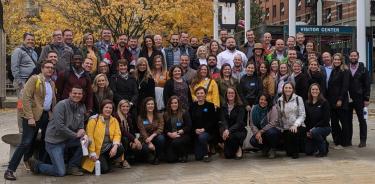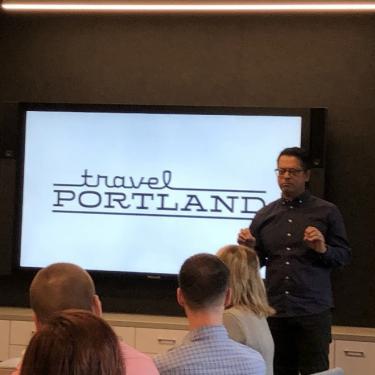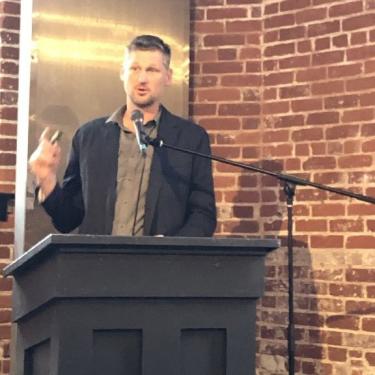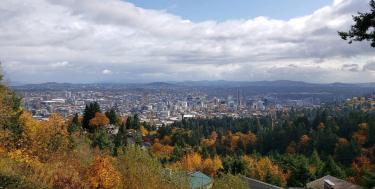2019 Centurions Benchmarking Trip: Portland
October 17-18, 2019
Centurions arrived in Portland and were welcomed with a toast at our fantastic HQ for our Portland, Oregon Benchmarking Trip, the Hi-Lo hotel, on Wednesday night. On Thursday morning, we started the day with a walk through pedestrian-friendly downtown to kick things off at Travel Portland.

Travel Portland – “You Can, in Portland” – Thursday Morning
At Travel Portland, we heard from Megan Conway, Senior Vice President of Communications, and Ajay Date, Vice President of Marketing, from their offices featuring a beautiful vista overlooking the Willamette River. Megan and Ajay welcomed us to their city and explained how “You Can, in Portland.” Travel Portland and Portlanders have an emphasis on community-minded values that benefits residents, as well as travelers. Global consciousness about Portland is growing. But ultimately, for Travel Portland, their objectives still come back to supporting their local community and businesses. Portland is deliberate about its brand and says their success is more than just looks or perception from media, like Portlandia. The city’s values are expressive, collaborative, and dynamic, according to Megan and Ajay.
Right now, Travel Portland is rolling out new a tourism platform called My Peoples Market for travelers to connect with the Portland hospitality, featuring an emphasis on minority and women business enterprises and makers. Megan and Ajay showed Centurions how this platform will be a great way to show the world that all Portland business are partners in bringing Portland to the world.

Travel Portland also works to improve local business effectiveness in attracting travelers once they are on the ground in Portland. Their team has led an effort to have every business Google-verified. Doing so, makes the business more visible and makes clear that all Portland businesses are partners in making Portland more accessible to the world. Travel Portland is doing the right things for travelers and for the local community.
After wrapping up at Travel Portland, Centurions were back on foot, walking across downtown quickly to the next destination. On the way, we stopped for a quick break and group photo in Director Park.
Integrated Land Use and Transportation Planning to Manage Growth
At The Armory, a historic building that is now a performing arts theater in the heart of the Pearl District, we heard from a panel of transit and urban planning experts, Alan Lehto, Director of Business Planning & Asset Management for TriMet, Portland’s transit agency, Dan Bower, Executive Director of Portland Streetcar Inc., and Robert Hastings, Agency Architect for TriMet. The panel was enlightening and reinforced much of what Kansas City does well in planning and land use and just how far we must go in matching up to a city like Portland on transit.
Alan established that the first thing to know about Portland planning and transit starts with the Willamette Valley - it influences everything and is the region’s “Eden.” Portland’s Urban Growth Boundary preserves that “Eden” by restricting growth within the Boundary’s lines. Urban planning has been utilizing the Boundary to develop new spaces, while preserving farm and forest for generations. It’s a progressive concept that has led to a progressive transit system.
Bob Hastings added to the discussion of Portland’s progressive planning and growth by explaining how architecture and design guide conversation and thoughtfulness of development in the Portland region. Transit is what informs Portland’s built environments. And being thoughtful is important because the greater Portland region consists of three counties and 26 separate communities- there are lessons in collaboration and partnership that Kansas City should replicate! Portland proves that a region consisting of many county and city stakeholders can have expansive transit and cohesive planning.


To wrap up the panel, Dan Bower explained to Centurions how the Portland Streetcar has spurred development all along its circular route around downtown and across the Willamette River. Dan works with his colleagues and other transit leaders to dispel the cliché that streetcars are a toy for developers. The Portland streetcar is much more than just meant to spur development- it moves people. In fact, more than 66% of daily streetcar rides are to and from the rider’s residence, which shows its integral part of daily life. Kansas City would be well served to make sure diverse housing options are available along its line just like in Portland.
And because Portland has a mature and innovative streetcar system, it has been able to respond to TriMet’s light rail growth and development. Streetcar shapes Portland’s urban landscapes where light rail lines cannot travel due to density or tight spaces. But with a mature streetcar comes challenges to manage and maintain Streetcar’s aging assets - a challenge in KC’s future but that we should be planning for today.
After the transit and planning panel, Centurions were off to a fun, nearby microbrewery, Von Ebert Brewing for lunch.
Portland’s Bureaus – Thursday Afternoon
In the afternoon, we heard from Portland's Chief of Police, Danielle Outlaw. She started her law enforcement career in California, and now is one of six African American women who serve as police chiefs in major cities. She informed the Centurions that the major issues facing Portland include: homelessness, mass demonstrations and protest, and violent crime. One of her major goals has been to improve the relationship between the police and the Portland community, noting that Portland is very "relational." One of the major achievements of her police department is the Behavioral Health Unit. While it was the result of consent decree with the Department of Justice, as the Portland Police Department was viewed as having challenges with the use of excessive force against people with mental health issues - it is not a now model program for other departments throughout the country.
Next we got to learn all about the Pearl District and its economic development. The Executive Director of the Pearl District Business, Julia Gustafson, was joined by Pearl District business owners WIlliam Mitchell (Merchant Concepts), Ramzy Hattar River Pig Saloon), and Linda Stimac (Firebrand Sports). Each talked about being drawn to the Pearl District to start their businesses because of the character, creativity, and history of the area. They noted that the Pearl District has a strong sense of community and that minority and women owned businesses are common. Each also agreed that having an active, advocate business association was instrumental in the Pearl District's success.
After the economic panel concluded, we walked to Proper Portland, the city's economic development agency. There, Cupid Alexander (Director of Strategic Initiatives, Mayor's Office) talked to us about the various challenges with Portland's government. In particular, he observed that the City Commission is fundamentally inequitable, because it is not based on representative districts. Cupid informed us that there have been numerous attempts to change the city's government into representative districts, but it has never been effectuated.
After Cupid finished his remarks, Troels Adrian (Business & Industry Manager, Prosper Portland) spoke to us about Propose Portland and the city's economic landscape. Troels informed us that despite the city's smaller size, Portland is the 8th wealthiest city in the country. A particularly impressive feat, given that in the 1970s and 80s Portland experienced a serious economic fallout with Georgia Pacific and the steel industry leaving. Portland leaders were very intentional about how they were going to build the city's economy moving forward. Instead of building lots of big highways and suburbs like other big cities, Portland focused on its uniqueness. Now, the city's industry cluster includes software, athletic companies, clean technology, and advanced manufacturing. Looking toward the future, Portland Prosper is focusing on how the city builds an equitable economy, including items such as a living wage, work experience for underrepresented youth, intentional purchasing from business of color, and culture change DEI training for businesses.
Urban Planning – Friday Morning
After a very full first day, we kicked off day two by discussing Portland’s urban planning initiatives with two architects that have been instrumental in designing spaces in Portland, but also originally hailed from Kansas City and understand the differences and challenges of each city. Jerome Unterreiner and Kristin Crain of ZGF Architects shared with us how ZGF has worked hand in hand with the City of Portland for more than two decades to help shape redevelopment along several riverfront district.
Key takeaways for successful urban development include:
- Have a long-term plan (20-40 year visions). The plan will change, but you won’t make any progress if you don’t have a roadmap to follow. (Oregon mandated this at the state level in the 1970s. Kansas, Missouri and Kansas City do not require municipalities to have long-term plans.
- The most important part of planning neighborhoods is creating spaces that make people want to congregate naturally. If the streets are not walkable and don’t include public gathering areas like green spaces, people won’t hang out.
- Density is a must for successful urban districts, it makes shared services and public transit more sustainable. Portland is forced to become more dense if they want to grow in population because they have a legally mandated Urban Growth Boundary that prohibits urban sprawl. Kansas City does not have anything that limits urban sprawl, which makes planning for density even more important.
- Mixed use, mixed income housing, and public/private partnerships are vital to healthy communities.
Speakers: Gary Cobb, Mary-Rain O’Meara, Sharon Fitzgerald, Andy Mendenhall, M.D., Clay Cooper, Leslie Tallyn
Investing in Sustainability
Next we heard from Johanna Brickman of VertueLab, which makes investments in emerging sustainable technologies. The organization has a foundation in economic development but is really dedicated to curbing climate change. From Jo, we learned that Kansas City should be very concerned with climate change because we are ranked #5 for cities that will be most impacted by its effects. Portland is ranked #13.
VertueLab is focused on technology as a path forward because it’s faster than trying to change behavior. However, less than 3 percent of philanthropic funds go to climate change causes. But they are seeing a massive rise in “impact investments” stemming from generational wealth being transferred to the Millennial generation which is much more conscientious of climate change and sustainability.
Impact investing is different than traditional investing or venture capitalism because the return on investment is measured more by the social impact rather than how much money the investment makes. Some impact investments have a market rate financial return but has a philanthropic angle. Some are straight investments in a cause without any sort of financial return.
Diversity in Entrepreneurship
The last duo we heard from before lunch was Paige Hendrix Buckner, program director at Founder Gym and founder of ClientJoy, and Stephen Green, director of operations at Pensole Design Academy and founder of Pitch Black. Paige and Stephen talked to us about the work they do to promote and support women and minority entrepreneurs.
The challenges that women and people of color face when trying to raise capital (or even just get small business loans) are unique. It’s not uncommon for women to get asked about maternity plans and if they think they can balance being a business owner and a mother. People of color often have their credentials scrutinized - the legitimacy of their education and experience questioned.
While both FounderGym and Pitch Black work to support entrepreneurs, they are not in the business of anti-poverty work. They are in the business of wealth creation. Anti-poverty does not equal wealth creation. And diversity and equity cannot be fully attained until all groups have pathways to wealth creation.
Homelessness in Portland – “No one chooses to be homeless”
With a 3 percent unemployment rate, rising home prices and overall higher cost of living, Portland has a growing homeless population. Central City Concern, like Kansas City’s ReStart program, has had refocus its services and build creative tools to combat the growing population epidemic. In addition to drug abuse, the city organization largely focuses on mental health issues and providing services to help prepare people to transition back into the workforce. For example, the organization’s Clean and Safe Program helps ease people back into a working by providing a job cleaning the community improvement district. Individuals are given a level of responsibility while they are overseen and coached on handling the stresses of going back to work. The business community has also played a large part in helping combat homeless by hiring 829 people that have gone through Central City’s targeted programs.
Portland has experienced great economic progress over the past few decades, but because of several factors, the number of homeless citizens in Portland has also risen dramatically. The problem being exacerbated by mental illness and addiction problems. Central City Concern believes that with the right support system in place that they can help rehabilitate and transition much of the homeless population back into functional society.
They have a holistic approach to services. They operate with a “no wrong door” policy, which means that they strive to get the right support for the person coming into the system regardless of which facility they entered and regardless of which service they initially requested. Services include, but are not limited to:
Housing: Mostly transitional in nature with the purpose of being temporary until someone is ready to live in a home on their own accord, CCC takes a housing first approach. If someone knows they have a stable roof over their head it’s easier for them to be successful in addiction rehabilitation, job training and more.
Medical and mental health support: This takes several forms, but many of the portion of the services they provide routine health services, outpatient procedures and rehabilitation, and dental work. Mental health is a huge part of what they do as mental illness is a leading characteristic shared by the homeless.
Education and career services: Many of the homeless population, have lived outside of mainstream society long enough, that what seems completely normal to us, is completely foreign to them. They have to relearn behavioral expectations for work and social settings, and also life management skills like cooking, keeping a budget and more.
Central City Concern operates 2,100 housing units, but even with that, it is estimated that approximately 2,800 people will be sleeping outside on any given night in Portland. In a metro that has roughly the same overall population as the Kansas City metro, the homeless problem is much worse. Our cohort was shocked seeing the number of people on the streets and the tents that were set up as shelter throughout the city.
What Makes Portland Work – Friday Afternoon
The State of Oregon mandates each community develop comprehensive plan which helps establish the long-term vision for each community. This strategy has allowed Portland leadership to step back and examine major issues facing their community including crime, red lining, demolition of historic business districts, poor quality and extensive freeway construction and decides to intentionally change direction. Mayoral Candidate Sarah Lannarone discussed how focused City leadership helped stop sprawl and allowed the community to reimagine their city center. The community also focused on building prosperity and inclusivity bringing together neighborhoods and communities around common causes. The intentionality and collaboration has helped Portland progress often placing it at the top of many national lists.
Cannabis: A Budding Industry
As one of the first states to legalize marijuana, Oregon and Portland have had to create new regulations for the growing industry. New permits and regulations have been put in place monitoring health grade versus recreational cannabis. Cannabis also has a state and local tax that goes to providing services to community services including homelessness and drug addiction. While the new industry has helped grow Portland’s economy, the City and State are still maneuvering challenges of the new industry.
In Conclusion:
“Geography is destiny.” Portland, Oregon’s location provides a landscape and attractions that brings people to the city from all over the world. During our trip we learned about the city’s culture, transportation, entrepreneurship, government and homelessness and what the City is doing to build a sustainable and prosperous community. No city with without issues but Portland is facing theirs head-on. The City, at the direction of its leaders, has reimaged their future and changed directions intentionally to meet their goal of a connected and sustainable community.
Special Thanks
Task Force Committee Chairs: Jackie Feeney, Paul Ramlow, Ashley Renfrew
Task Force Committee: Kelli Broers, John Coler, Kyle Kennedy, Solissa McKay, Erika O’Shea, Jamie Thomas,
Sponsors: Thanks to sponsors Terracon, VisitKC, MVPLaw, Travel Portland

